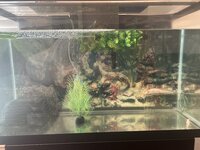SquirrelBait
New member
Hello Everyone! I’ll give you some quick background info. I’ve kept freshwater aquariums very successfully for about 8 years. I got a new tank and stand for Black Friday and went to my favorite and most highly recommended pet store to look for some new fish friends. Well they had Axolotls for super cheap and my little boy went crazy! I ended up with 2 of them (I only knew the care instructions they talked me through. I have a 30 gallon tank. When they are fully grown I will most likely put them in a 55 but for now the 30 seems acceptable. Now I have 2 pink axolotls (super neat and super cute) and am trying to learn as much as I can to give them the best life possible. My water parameters are surprisingly really good for a new cycle but I did do a filter squeeze since I put them in same day. Ammonia and Nitrites are 0, nitrate is very close to 0. BTW, I am on a very small budget right now.
So questions…
1. Is there anything I can do to help the regeneration of their feet and gills? I got 2 very small ones (3-5”) and they have no feet and gills are pretty short.
2. Should I add sand? If so, is there anything in particular I need to look for?
3. I’d like to start breeding something live for them to eat (on a small scale b/c they’ve been eating pellets fine). What do you recommend? I’ve heard ghost shrimp are good but I want to be sure. I would have them in a floating breeder in a tank.
4. It’s only been a few days but why won’t they eat the food at the bottom of the tank? They eat pellets when I use the tweezer things and hold it just under their mouth but if I drop it in front of them they won’t touch it and I have to remove it.
5. I have a hang-on-the-back 40-60 gallon filter with a large fake plant directly under it to deter the flow and a small bubbler recommended for 15 gallons. Is that too much or not enough oxygen, or is it fine? I’m worried about them breathing okay, the larger of the two was going up for air about every 5-15 minutes before the bubbler (the small one almost never does) but since I added the bubbler it seems to be just maybe once every couple hours or so. I’m concerned b/c they were in a tank with at least 4 dozen others and their gills don’t seem so great compared to pictures I’ve seen.
I may be a little paranoid but this is new for me and I’ve fallen hard for these little guys. Thank you so so much in advance for any questions you may answer.
So questions…
1. Is there anything I can do to help the regeneration of their feet and gills? I got 2 very small ones (3-5”) and they have no feet and gills are pretty short.
2. Should I add sand? If so, is there anything in particular I need to look for?
3. I’d like to start breeding something live for them to eat (on a small scale b/c they’ve been eating pellets fine). What do you recommend? I’ve heard ghost shrimp are good but I want to be sure. I would have them in a floating breeder in a tank.
4. It’s only been a few days but why won’t they eat the food at the bottom of the tank? They eat pellets when I use the tweezer things and hold it just under their mouth but if I drop it in front of them they won’t touch it and I have to remove it.
5. I have a hang-on-the-back 40-60 gallon filter with a large fake plant directly under it to deter the flow and a small bubbler recommended for 15 gallons. Is that too much or not enough oxygen, or is it fine? I’m worried about them breathing okay, the larger of the two was going up for air about every 5-15 minutes before the bubbler (the small one almost never does) but since I added the bubbler it seems to be just maybe once every couple hours or so. I’m concerned b/c they were in a tank with at least 4 dozen others and their gills don’t seem so great compared to pictures I’ve seen.
I may be a little paranoid but this is new for me and I’ve fallen hard for these little guys. Thank you so so much in advance for any questions you may answer.


